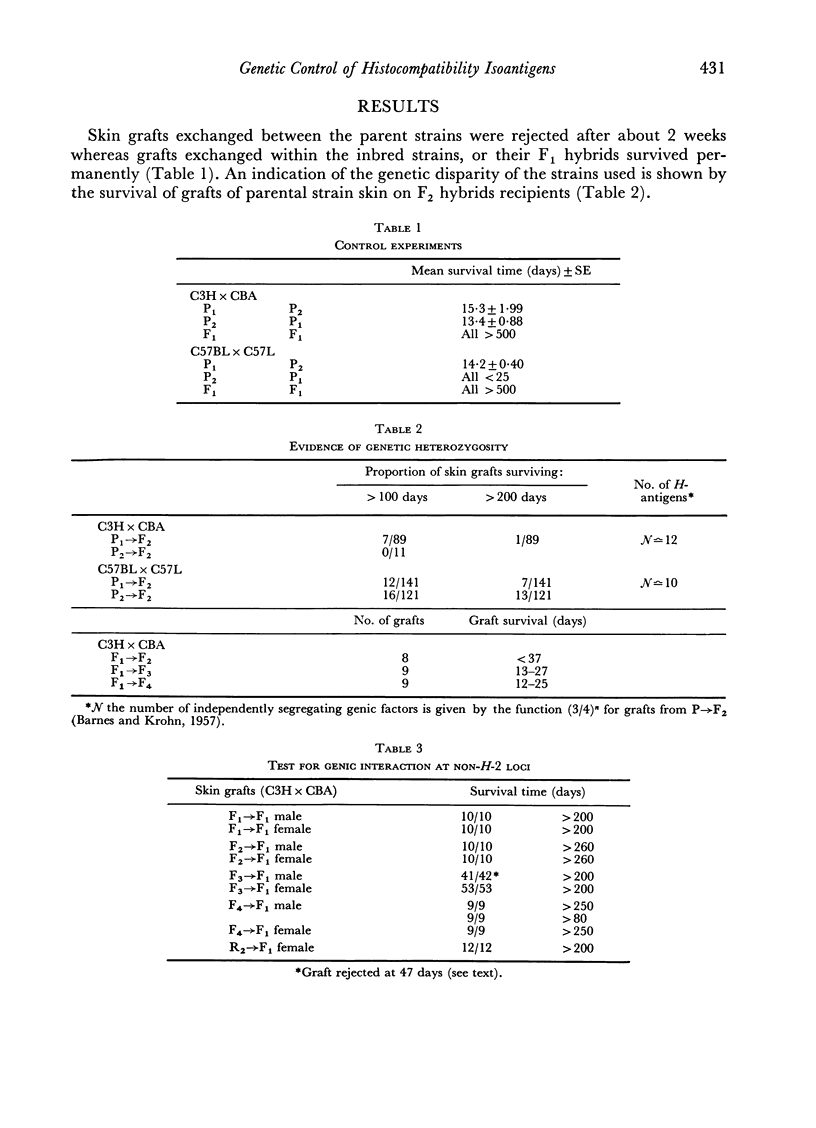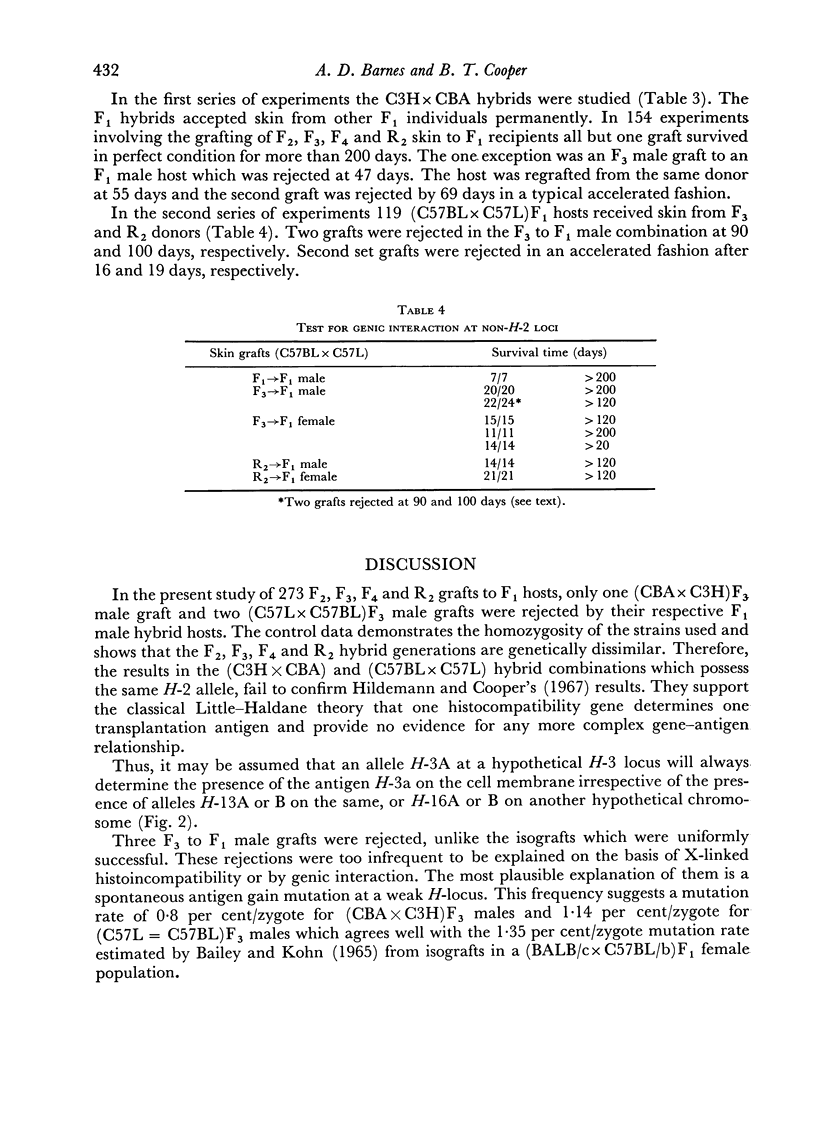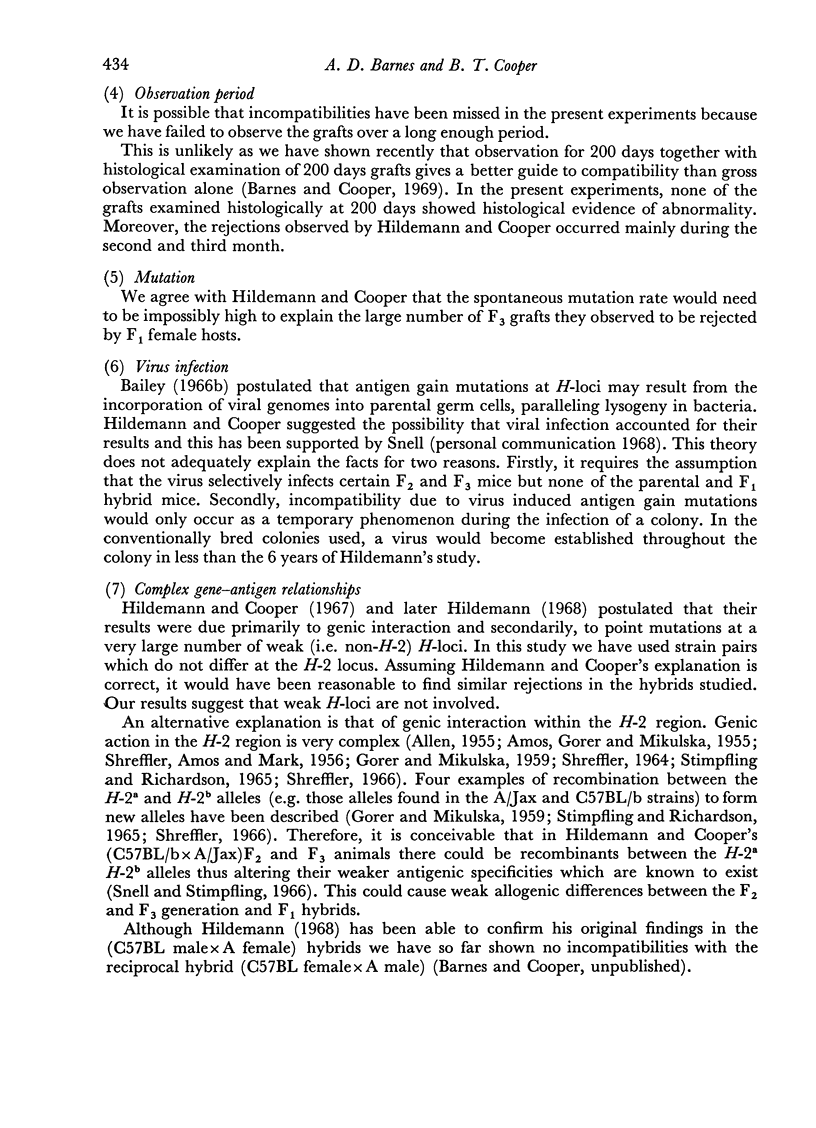Abstract
This study provides evidence in mice of three strain combinations, that the classical law of transplantation that one gene ⇌ one antigen is applicable. It fails to confirm the suggestion that genic interaction may operate between the histocompatibility loci.
Full text
PDF






Selected References
These references are in PubMed. This may not be the complete list of references from this article.
- AMOS D. B., GORER P. A., MIKULSKA Z. B. An analysis of an antigenic system in the mouse (the H-2 system). Proc R Soc Lond B Biol Sci. 1955 Nov 29;144(916):369–380. doi: 10.1098/rspb.1955.0064. [DOI] [PubMed] [Google Scholar]
- Allen S L. Linkage Relations of the Genes Histocompatibility-2 and Fused Tail, Brachyury and Kinky Tail in the Mouse, as Determined by Tumor Transplantation. Genetics. 1955 Sep;40(5):627–650. doi: 10.1093/genetics/40.5.627. [DOI] [PMC free article] [PubMed] [Google Scholar]
- BAILEY D. W. Histoincompatibility associated with the X chromosome in mice. Transplantation. 1963 Jan;1:70–74. doi: 10.1097/00007890-196301010-00009. [DOI] [PubMed] [Google Scholar]
- BARNES A. D., KROHN P. L. The estimation of the number of histocompatibility genes controlling the successful transplantation of normal skin in mice. Proc R Soc Lond B Biol Sci. 1957 Jun 25;146(925):505–526. doi: 10.1098/rspb.1957.0027. [DOI] [PubMed] [Google Scholar]
- Bailey D. W. Heritable histocompatibility changes: lysogeny in mice? Transplantation. 1966 Jul;4(4):482–488. doi: 10.1097/00007890-196607000-00012. [DOI] [PubMed] [Google Scholar]
- Bailey D. W., Kohn H. I. Inherited histocompatibility changes in progeny of irradiated and unirradiated inbred mice. Genet Res. 1965 Nov;6(3):330–340. doi: 10.1017/s0016672300004225. [DOI] [PubMed] [Google Scholar]
- Boyse E. A., Stockert E., Old L. J. Isoantigens of the H-2 and Tla loci of the mouse: interactions affecting their representation on thymocytes. J Exp Med. 1968 Jul 1;128(1):85–95. doi: 10.1084/jem.128.1.85. [DOI] [PMC free article] [PubMed] [Google Scholar]
- COHEN C. Occurrence of three red blood cell antigens in rabbit as the result of interaction of two genes. Science. 1956 May 25;123(3204):935–936. doi: 10.1126/science.123.3204.935. [DOI] [PubMed] [Google Scholar]
- FOX A. S. Genetics of tissue specificity. Ann N Y Acad Sci. 1958 Oct 7;73(3):611–634. doi: 10.1111/j.1749-6632.1959.tb40839.x. [DOI] [PubMed] [Google Scholar]
- GOODMAN J. W. A SEARCH FOR PARENTAL ANTIGENS NOT EXPRESSED IN F1 HYBRID MICE. Transplantation. 1965 Mar;3:190–201. doi: 10.1097/00007890-196503000-00007. [DOI] [PubMed] [Google Scholar]
- Hildemann W. H., Cooper E. L. Transplantation genetics: unexpected histoincompatibility associated with skin grafts from F2 and F3 hybrid donors to F1 hybrid recipients. Transplantation. 1967 Jul;5(4):707–720. [PubMed] [Google Scholar]
- Irwin M. R. Interaction of nonallelic genes on cellular antigens in species hybrids of Columbidae. II. Identification of interacting genes. Proc Natl Acad Sci U S A. 1966 Jan;55(1):34–40. doi: 10.1073/pnas.55.1.34. [DOI] [PMC free article] [PubMed] [Google Scholar]
- Irwin M. R. Interaction of nonallelic genes on cellular antigens in species hybrids of columbidae, iii. Further identification of interacting genes. Proc Natl Acad Sci U S A. 1966 Jul;56(1):93–98. doi: 10.1073/pnas.56.1.93. [DOI] [PMC free article] [PubMed] [Google Scholar]
- Lapp W. S., Bliss J. Q. Skin graft size: its effect on graft survival in mice incompatible at a weak locus. Transplantation. 1966 Nov;4(6):754–755. doi: 10.1097/00007890-196611000-00011. [DOI] [PubMed] [Google Scholar]
- Little C. C. A POSSIBLE MENDELIAN EXPLANATION FOR A TYPE OF INHERITANCE APPARENTLY NON-MENDELIAN IN NATURE. Science. 1914 Dec 18;40(1042):904–906. doi: 10.1126/science.40.1042.904. [DOI] [PubMed] [Google Scholar]
- MARTINEZ C., SHAPIRO F., GOOD R. A. Absence of gene interaction in mouse hybrids, revealed by studies of immunological tolerance and homotransplantation. Proc Soc Exp Biol Med. 1959 Aug-Sep;101:658–660. doi: 10.3181/00379727-101-25051. [DOI] [PubMed] [Google Scholar]
- SHREFFLER D. C. A SEROLOGICALLY DETECTED VARIANT IN MOUSE SERUM: FURTHER EVIDENCE FOR GENETIC CONTROL BY THE HISTOCOMPATIBILITY-2 LOCUS. Genetics. 1964 Jun;49:973–978. doi: 10.1093/genetics/49.6.973. [DOI] [PMC free article] [PubMed] [Google Scholar]
- SNELL G. D. The genetics of transplantation. J Natl Cancer Inst. 1953 Dec;14(3):691-700; discussion, 701-4. [PubMed] [Google Scholar]
- STIMPFLING J. H., RICHARDSON A. RECOMBINATION WITHIN THE HISTOCOMPATIBILITY LOCUS OF THE MOUSE. Genetics. 1965 May;51:831–846. doi: 10.1093/genetics/51.5.831. [DOI] [PMC free article] [PubMed] [Google Scholar]
- STORMONT C., OWEN R. D., IRWIN M. R. The B and C systems of bovine blood groups. Genetics. 1951 Mar;36(2):134–161. doi: 10.1093/genetics/36.2.134. [DOI] [PMC free article] [PubMed] [Google Scholar]
- Shreffler D. C., Amos D. B., Mark R. Serological analysis of a recombination in the H-2 region of the mouse. Transplantation. 1966 May;4(3):300–322. doi: 10.1097/00007890-196605000-00008. [DOI] [PubMed] [Google Scholar]
- Watkins W. M. Blood-group substances. Science. 1966 Apr 8;152(3719):172–181. doi: 10.1126/science.152.3719.172. [DOI] [PubMed] [Google Scholar]
- Zanella G., Reif A. E., Buenviaje O. L., Asakuma R., Deterlig R. A., Jr On prolonged survival of massive skin allografts in mice. Transplantation. 1968 Nov;6(8):885–894. doi: 10.1097/00007890-196811000-00003. [DOI] [PubMed] [Google Scholar]


